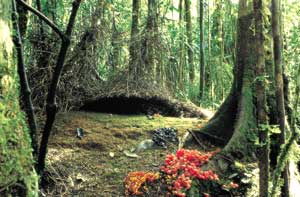Bowerbirds: Nature's Interior Designers
Biology 342 Fall 07
Valerie Conrad and Hannah Smith
Ontogeny
Learning to Build
 [4]
[4]
Male bowerbirds spend years perfecting the art of construction, necessitating mastery of both the needed skills and capabilities, and a thorough understanding of the accepted style of bower for their species and regional population. Physical prowess and creativity are no asset if the male's bower is the wrong style or contains unacceptable objects, such that the appropriate bower type seems to be a cultural norm.
The construction of an attractive bowers appears to rely heavily on learned behaviors. Perfecting the art of bower building is a combination of developing the manual dexterity and spatial and memory skills needed to physically erect the bower, and the artistic talent to create an edifice capable of enticing females. Males must be strong enough to carry twigs and decorations long distances, and then manuver them into a pleasing and sturdy shape. Consequently, the first seven years of a male's life are spent honing the necessary skills and reaching maturity, although he may never build a bower that will win him a mate.
Within a species, populations can display widely different styles of bower, causing some to hypothesize that bower style is a "cultural" trait (Diamond). Older immature males of the satin bowerbird appear to instruct younger juveniles on proper construction and ornamentation, using communal practice bower sites. The young males lacking experience in bower construction will attempt to use inappropriate materials, such as sticks too thick for construction or ornaments inconsistent with the standard bower of that population . This indicates that sucessful bower construction requires experience and knowledge of the appropriate species-specific, regional style of bower, as well as possibly the genetic components of a well-developed spatial memory, the ability to innovate, and the instinct to learn and perfect the process of construction.
Further evidence of the cultural transmission of bower style are cases of interspecific bower similarity. In one instance, a spotted bowerbird living outside the typical geographical distribution of the species in close proximity to satin bowerbirds built a bower similar to those of satin bowerbirds, and prefered ornamentation fitting with the common color scheme of the local satin bowerbirds, rather than that of spotted bowerbirds. Intraspecific variations also tend to be localized, with birds living in the same area following trends that occur with the introduction of a novel ornament to one of the nearby bowers.